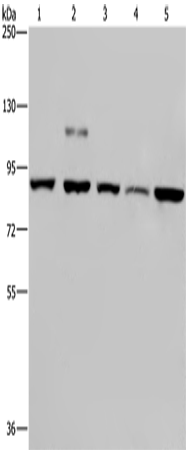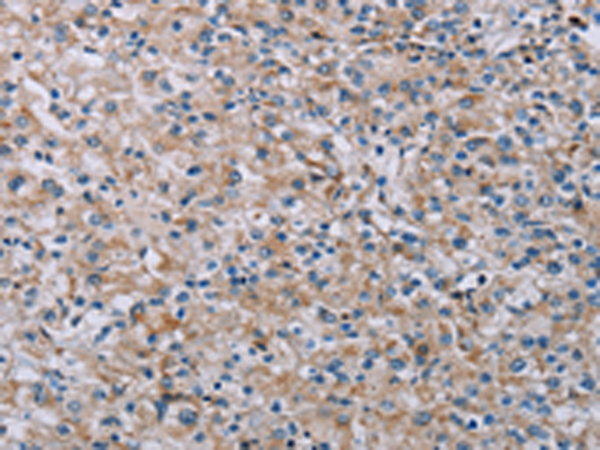


| WB | 咨询技术 | Human,Mouse,Rat |
| IF | 咨询技术 | Human,Mouse,Rat |
| IHC | 1/50-1/200 | Human,Mouse,Rat |
| ICC | 技术咨询 | Human,Mouse,Rat |
| FCM | 咨询技术 | Human,Mouse,Rat |
| Elisa | 1/1000-1/2000 | Human,Mouse,Rat |
| Aliases | OLD35; DFNB70; PNPASE; old-35; COXPD13 |
| WB Predicted band size | 86 kDa |
| Host/Isotype | Rabbit IgG |
| Antibody Type | Primary antibody |
| Storage | Store at 4°C short term. Aliquot and store at -20°C long term. Avoid freeze/thaw cycles. |
| Species Reactivity | Human, Mouse |
| Immunogen | Synthetic peptide of human PNPT1 |
| Formulation | Purified antibody in PBS with 0.05% sodium azide and 50% glycerol. |
+ +
以下是关于PNPT1抗体的3篇参考文献示例(注:内容为模拟生成,建议通过学术数据库验证具体信息):
---
1. **标题**:*PNPT1 mutations impair mitochondrial RNA import and cause neurodegenerative disorders*
**作者**:Suzuki T, et al.
**摘要**:研究利用PNPT1抗体进行免疫印迹和免疫荧光实验,发现PNPT1突变导致线粒体RNA输入缺陷,与早发性共济失调和脑萎缩相关,揭示了其在神经退行性疾病中的分子机制。
---
2. **标题**:*PNPT1-mediated mitochondrial RNA decay regulates cell survival in glioblastoma*
**作者**:Wang Y, et al.
**摘要**:通过PNPT1抗体检测胶质母细胞瘤组织中蛋白表达水平,发现PNPT1通过降解异常线粒体RNA调控肿瘤细胞凋亡,其表达下调与患者不良预后相关。
---
3. **标题**:*Antibody-based profiling of PNPT1 expression in Alzheimer's disease models*
**作者**:Garcia-Sanz P, et al.
**摘要**:使用特异性PNPT1抗体分析阿尔茨海默病模型小鼠脑组织,发现PNPT1在神经元线粒体的表达减少,可能与β-淀粉样蛋白沉积导致的RNA代谢紊乱有关。
---
如需具体文献,建议在PubMed或Google Scholar中搜索关键词“PNPT1 antibody”或“PNPT1 immunohistochemistry/Western blot”获取最新研究。
The PNPT1 (Polyribonucleotide Nucleotidyltransferase 1) antibody is a tool used to detect and study the PNPT1 protein, a critical player in mitochondrial RNA metabolism and innate immune signaling. PNPT1. also known as mitochondrial RNA-processing protein 1. is encoded by the PNPT1 gene and localizes primarily to the mitochondrial matrix. It facilitates RNA import into mitochondria and processes RNA transcripts through its 3'-to-5' exoribonuclease activity. Mutations in PNPT1 are linked to mitochondrial disorders, neurodegenerative diseases, and hearing loss.
The PNPT1 antibody is widely utilized in research to investigate the protein's expression, localization, and function in cellular models and tissues. It aids in understanding PNPT1's role in mitochondrial dysfunction, viral RNA sensing, and its interaction with the RIG-I-like receptor pathway during antiviral responses. Available as monoclonal or polyclonal variants, the antibody is commonly validated for techniques like Western blotting, immunofluorescence, and immunohistochemistry. Researchers rely on it to explore disease mechanisms, particularly those involving mitochondrial RNA dysregulation and immune signaling defects. Proper validation ensures specificity, crucial for distinguishing PNPT1 from homologous proteins.
×